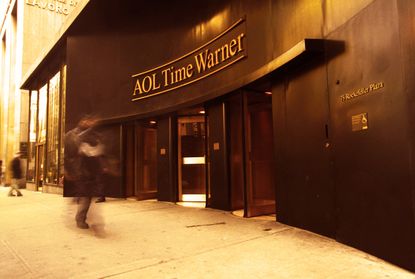Will AOL's new merger go better than the last one?
The shadow of Time Warner hangs over AOL's deal with Verizon


For anyone looking for a takeaway from Verizon's surprise move, announced on Tuesday, to buy AOL, the lesson might be this: Sometimes discretion is the better part of valor.
The deal will go down for the relatively modest sum of $4.4 billion, and should be completed sometime in the summer, assuming all is cool with federal regulators. But compare that price tag to what happened 15 years ago this January, when AOL — then at the peak of its powers — bought Time Warner for a staggering $165 billion, creating a combined company valued at $350 billion. The word "transformational" was bandied about so much to describe the deal that it's now considered something of a wry joke. It remains one of the largest mergers — if not the largest merger — in corporate history.
And within a few years it came entirely unglued.
Subscribe to The Week
Escape your echo chamber. Get the facts behind the news, plus analysis from multiple perspectives.

Sign up for The Week's Free Newsletters
From our morning news briefing to a weekly Good News Newsletter, get the best of The Week delivered directly to your inbox.
From our morning news briefing to a weekly Good News Newsletter, get the best of The Week delivered directly to your inbox.
Just months after the deal, the dot-com bubble burst and the country slipped into a recession. While Time Warner brought its incipient broadband network to the arrangement, the newly formed company still relied heavily on AOL's dial-up service. The advent of mass broadband internet brought the behemoth to its knees, and the total value of AOL's stock subsequently fell from $226 billion to $20 billion. By 2009, TimeWarner had spun AOL off into a separate company.
These days, AOL is valued at around $3.3 billion, and Time Warner at around $68 billion. Along with one of the biggest deals in corporate history, it's now considered one of the biggest catastrophes as well.
So what happened? And can the new Verizon-AOL merger avoid a similar fate?
Everyone seems to agree that the execution of the deal and the subsequent business model could have been better. A culture clash also appears to have played a role: Time Warner was an old-school media and publishing giant while AOL was an upstart internet company — the prototype for the "move fast and break stuff" ethos that Silicon Valley has made infamous.
But the real issue cuts deeper. As Katie Benner, a Bloomberg columnist and a former Time Warner employee, put it in January, the AOL-Time Warner merger was based on a pretty simple theory: To survive in the digital world, an old-school company like Time Warner needed to bring all aspects of the new digital ecosystem together — the software, the content, and the digital pipelines. It was principally about wedding content and distribution.
But the company failed to realize how the economics would play out when those factors were combined.
"When Time Inc.'s print products were distributed cheaply online across AOL's network, they decreased in value," Benner wrote. "The new distribution model hurt demand for high-cost print ads."
This is the problem that has bedeviled media producers of all sorts — from news to music and more — since the advent of digital. The fact that solid physical mediums like magazines and CDs are much more expensive to provide than digital bits of information is what made the business models in those sectors possible. And we still really don't know what the new sustainable business model is.
"Today, streaming music services get music to listeners more cheaply than ever before, but they haven't made it more profitable for labels and musicians to produce music," Benner continued. "BuzzFeed et al pay very little to get content in front of readers and viewers, but online ads alone aren't enough to support their growing newsrooms."
This time, Verizon-AOL will be trying to provide a platform for advertisements themselves: A big part of the deal is AOL's ad service technology, its video capabilities, and its personalization engine, which Verizon hopes it can combine with its mobile network to create an adverting bonanza.
But Verizon also intends to up its video content production game, providing short videos and shows, along with longer broadcast content like sports and concerts, straight to mobile devices. The plan "has left a lot of room for interpretation" as The Wall Street Journal put it, and it's not clear how it's structurally any different from the content-plus-distribution bet that AOL-Time Warner made.
The distribution component is a question, too. For one thing, the deal assumes Verizon's mammoth mobile network — already the largest in the country — will remain the distribution route of choice. But Google and Facebook are already experimenting with blimps to provide wireless, and they're laying down open fiber networks. Cable TV is already trying out wi-fi workarounds, and mobile-phone carriers are playing with using wi-fi as their go-to technology, with cellular as the backup.
In 2000, the assumption was that AOL's dial-up would be the distribution route for Time Warner's content. Then AOL was promptly decimated by broadband, which erupted from a 3 percent slice of the country in 2000 to 39 percent by 2003. Sometimes you don't see the technological tipping point until you've already fallen off it.
As Rita Gunter McGrath noted in a piece for Fortune, we seem to be entering another dot-com bubble era, in which massive sums of money are bet on romanticized notions of breakthrough ideas and technologies. "There are at least 48 venture-capital backed companies with an implied value of over $1 billion, while the number of such companies peaked at 10 during the height of the 2000 dot-com boom," she wrote.
It sure looks like another round of cosmic hubris and stock market bloat, in the face of the exact same endemic uncertainties about the future course of technology and the viability of particular business models that laid AOL-Time Warner low.
All that said, the Verizon-AOL deal may at least deserve credit for modesty. The new AOL-Verizon deal went down for a mere $4.4 billion, which seems downright prudent and cautious by comparison. And at least no one's saying "transformational" anymore.
Sign up for Today's Best Articles in your inbox
A free daily email with the biggest news stories of the day – and the best features from TheWeek.com
Jeff Spross was the economics and business correspondent at TheWeek.com. He was previously a reporter at ThinkProgress.
-
 5 hilariously spirited cartoons about the spirit of Christmas
5 hilariously spirited cartoons about the spirit of ChristmasCartoons Artists take on excuses, pardons, and more
By The Week US Published
-
 Inside the house of Assad
Inside the house of AssadThe Explainer Bashar al-Assad and his father, Hafez, ruled Syria for more than half a century but how did one family achieve and maintain power?
By The Week UK Published
-
 Sudoku medium: December 22, 2024
Sudoku medium: December 22, 2024The Week's daily medium sudoku puzzle
By The Week Staff Published